Note: this post was written before the Hizballah rocket attack which killed twelve children in Majdal Shams on the evening of 27/7/24.
Early on July 23rd the BBC promoted a report published on the BBC News website’s ‘Middle East’ page:
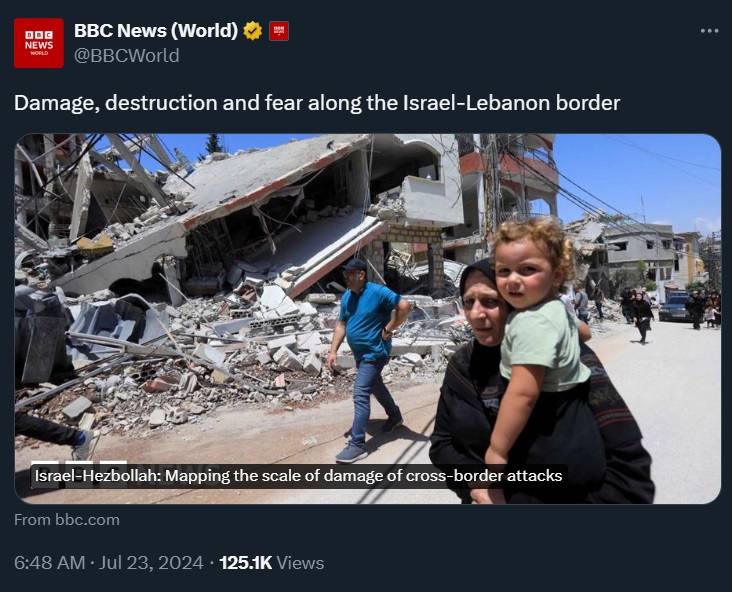
As can be understood from the credits, that report – titled “Damage, destruction and fear along the Israel-Lebanon border” and also translated into Arabic – is obviously the result of considerable time and effort on the part of multiple BBC journalists from several departments.
“Ahmed Nour, Peter Ball and BBC World Service Visual Journalism team, BBC Arabic & BBC World Service”
“Additional reporting: Carine Torbey, Michael Shuval, Joya Berbery, Daniele Palumbo”
Nevertheless, the report opens by failing to inform BBC audiences that Hizballah is a terrorist organisation proscribed by the UK and many other countries: [emphasis added]
“BBC analysis has uncovered the extent of damage caused by nine months of fighting between the Lebanese armed group Hezbollah and Israel.
Satellite photos, radar imagery and records of military activity show that entire communities have been displaced, with thousands of buildings and large swathes of open land damaged on the border between Israel and Lebanon.”
As has been the case in at least one previous item of BBC content, the report relies on data provided by ACLED.
“Data gathered by the US-based Armed Conflict Location and Event Data Project (Acled) and analysed by the BBC suggest both sides together carried out a combined 7,491 cross-border attacks between 8 October 2023 and 5 July 2024. These figures indicated that Israel has carried out around five times as many as Hezbollah.”
Readers are not told that ACLED data is sourced from local partners, including anonymous sources.
The report goes on:
“The UN says the attacks have forced more than 90,000 people in Lebanon from their homes, with around 100 civilians and 366 Hezbollah fighters killed in Israeli strikes.”
The BBC’s report does not clarify that some 68 operatives from other terrorist groups in Lebanon have also been killed.
Under the sub-heading “Southern Lebanon building damage”, readers find a graphic titled “Worst-hit towns in Southern Lebanon” which names three places: Aita el Shaab (also known as Ayta ash Shab), Blida and Kfar Kila.
“Analysis reveals more than 60% of the border communities in Lebanon have suffered some kind of damage as a result of Israeli air and artillery strikes. As of 10 July, more than 3,200 buildings may have suffered damage.
The findings were put together by Corey Scher of City University of New York Graduate Center and Jamon Van Den Hoek of Oregon State University. They are based on comparisons of about 500 separate images, revealing changes in the height or structure of buildings which suggests damage.
The towns of Aita el Shaab, Kfar Kila and Blida appear to have been among the worst affected.”
Readers may recall that in late January BBC Verify (including Daniele Palumbo, who is also credited in this report) used data provided by the same academics as the basis for claims concerning buildings in the Gaza Strip.
“Notably, three days after BBC Verify’s report appeared, the United Nations Satellite Centre – UNOSAT – published its own “assessment of the damage and destruction inflicted on structures in the Gaza Strip” which concluded that 30% (rather than 50% to 61% as claimed by the BBC) of the structures in the territory have been damaged since the beginning of the war.”
Readers of this report then find graphics relating to the first of the named Lebanese towns.
“Aita el Shaab has been extensively hit, with at least 299 attacks since October, according to Acled.”
Readers also find an interview with the mayor of that town which includes the following:
“Mr Tehini recalled seeing the town destroyed in the past, mainly in the 2006 war between Israel and Hezbollah, but he says the bombs have caused much bigger destruction this time.”
Notably, the BBC’s report does not bother to inform readers that the Hizballah attack which began the Second Lebanon war in 2006 was launched from the immediate vicinity of Aita el Shaab.
A report published by the New Yorker the day before this BBC report appeared shows that the town is still a centre of Hizballah operations:
“The people of Rmaych have a peculiar vantage point on the war. Father Najib pointed south, to a hilltop a few hundred yards away, where an antenna tower marked the Israeli border. Then he pointed northwest, to the neighboring village of Aita al-Shaab. “That’s a Hezbollah village,” he said. “We are in the middle.” Since the conflict began, he said, Hezbollah fighters had twice come into Rmaych, set up Katyusha rocket batteries, and fired into Israel. The last time, in December, an Israeli jet bombed a house in Rmaych that Hezbollah had commandeered. Afterward, Najib sent the group a message that it was not welcome. “We told them, ‘We can’t prevent you from passing through our town, but we will not let you fire from here,’ ” he said. “ ‘Put your missiles somewhere else.’ ”
The Hezbollah men left, but they kept up the fight from Aita al-Shaab, just across the hill. A few hours before I arrived, Najib said, militants there had fired rockets over the border. Israeli bombs landed moments later, exploding so fiercely that the earth shook.”
The Alma Centre has documented active Hizballah military zones in the area of Aita el Shaab (where a strike on a Hizballah weapons storage facility took place the night before this BBC report appeared) and near another of the towns highlighted by the BBC as “worst-hit”, Blida. The third town showcased by the BBC – Kfar Kila – is also known as a Hizballah stronghold.
The BBC’s report refrains from providing readers with any information about Hizballah’s documented entrenchment (including tunnels) in those three named locations and elsewhere in its own words and instead promotes vague statements from a third party: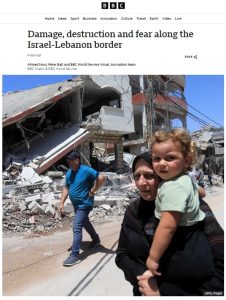
“Dr Burcu Ozcelik, a senior research fellow for Middle East security at Rusi said Israel is targeting towns in the border area because these are areas where it says Hezbollah is deeply entrenched.
“Israel believes that they have sufficient documented evidence that there are a network for fortifications and tunnels in the vicinity of homes.”
She said Israel is targeting this area to send a message to Hezbollah that they “should not be there”, but believes Hezbollah would find it unthinkable to evacuate.
“The US has been trying to find a middle ground, such as getting Hezbollah to withdraw four miles from the border. Hezbollah has rejected this.”
The Israel Defense Forces (IDF) told the BBC it has carried out strikes against military targets to “remove the threat posed by Hezbollah to Israel, its citizens, and their homes”.”
As has been the case in all BBC reporting on this story in the past nine months (and before), at no point are readers of this long report told that according to UN Security Council resolution 1701, Hizballah should be nowhere near the border between Israel and Lebanon and was supposed to have been disarmed eighteen years ago. The relevant topic of the UN’s failure to implement its own resolution by means of its ‘peacekeeping’ force UNIFIL is also conspicuously absent from this report.
Despite including a long section with six graphics pertaining to damage in three towns in southern Lebanon, the BBC’s report does not include any comparable study of damage to towns and villages in northern Israel such as Metula (where around 40% of the homes have been damaged), Kiryat Shmona, Shtula or Menara.
Instead, readers are told that “it’s the destruction of land which has been significant” in Israel and find a section sub-headed “Israel’s fire damage” which includes political signposting.
“Huge amounts of land have been burnt in both countries, but the BBC estimates that Israel and the Israeli-occupied Golan Heights have been hit hardest, with around 55 sq km (21 sq miles) of land affected, compared to 40 sq km for Lebanon.
Some recent estimates by Israel’s Nature and Park Authority have put this figure as high as 87 sq km.”
An update put out by the Nature and Parks Authority on July 7th stated that up to that date, 104,697 dunams (104.679 sq km) had been burned – around half in nature reserves and national parks.
Ahead of a graphic, the BBC’s report tells readers that:
“The scale of the damage is illustrated by images of the settlement of Katzrin in the Israeli-occupied Golan Heights. A huge swathe of burnt land, larger than the settlement itself, appeared after a barrage of rocket fire in early June.”
Readers are not informed that much of the land burned near Katzrin as a result of those attacks on June 2nd is a nature reserve.
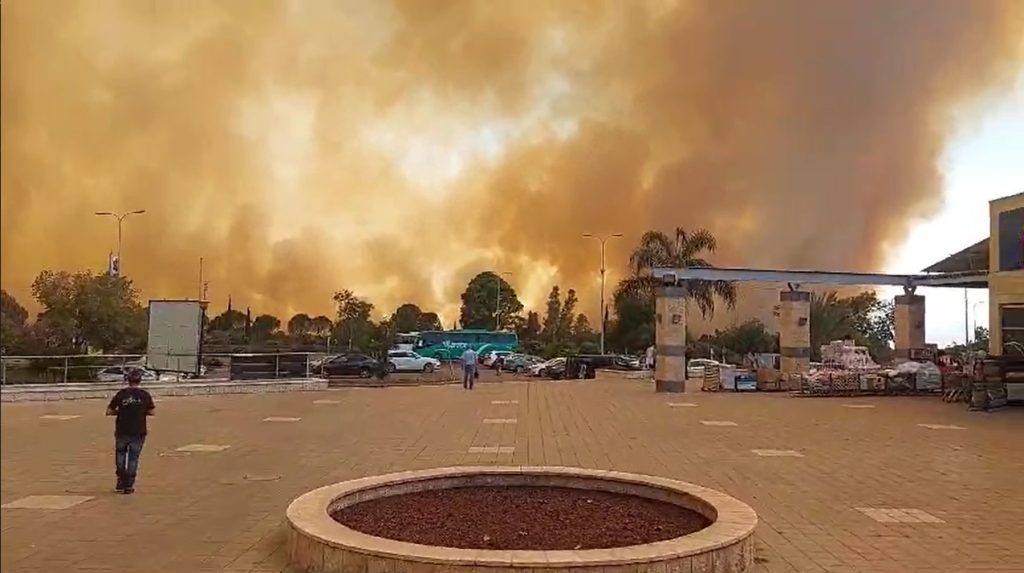
The BBC’s report then goes on to tell readers that Moshav Kfar Yuval is “About 20 miles (30km) to the north east” of Katzrin – which would put it right on the border with Syria rather than in the upper Galilee – and to mention a fatal rocket attack which it reported in January.
Readers next find uncritical promotion of Hizballah disinformation concerning the targets of Israeli strikes, without any mention of the topic of Hizballah’s entrenchment in towns and villages in southern Lebanon and resulting use of human shields:
“Hezbollah did not respond to a request for comment. But its leader Hassan Nasrallah said on Wednesday that the Israeli “persistence in targeting civilians” would push the group’s fighters to target new “settlements” with missiles and warned Israel that its tanks would be destroyed if they crossed into Lebanon.”
The next section of this report promotes the claims of an inadequately presented political NGO, as was the case in a BBC report from southern Lebanon published six days earlier.
“The international campaign group, Human Rights Watch, has verified the use of white phosphorus over several populated areas in southern Lebanon, including al-Bustan.
It says Israel’s use of white phosphorus is “unlawfully indiscriminate in populated areas”.
The IDF disputes this, saying the use of white phosphorus shells to create a smokescreen “is lawful under international law”. It says these shells are not used in densely populated areas “with certain exceptions”.”
The final section of the BBC’s report is headed “Concerns over escalation” and it includes another graphic sourced from ACLED.
“According to the Acled data, the intensity of hostilities between Israel and Hezbollah has not reduced since 8 October, with even a slight increase in the number of attacks between both sides in recent months.
Dr Ozcelik said there are concerns that any further escalation in fighting could trigger an all-out war, which could even draw Iran into a direct confrontation with Israel in defence of Hezbollah.
But, in a note of optimism, she said she believes both Israel and Hezbollah are trying to avoid that eventuality.
“Both sides are being quite calibrated in their approach across the border to avoid a misfire or a human error or a miscalculation.””
The BBC’s report ends on that note. Despite having earlier quoted the Hizballah leader’s July 17th speech in which he threatened to attack locations in Israel that have not previously been targeted, no mention is made of the fact that there has been an increase in Hizballah attacks on civilian communities which have not been evacuated and a widening of the areas under attack.
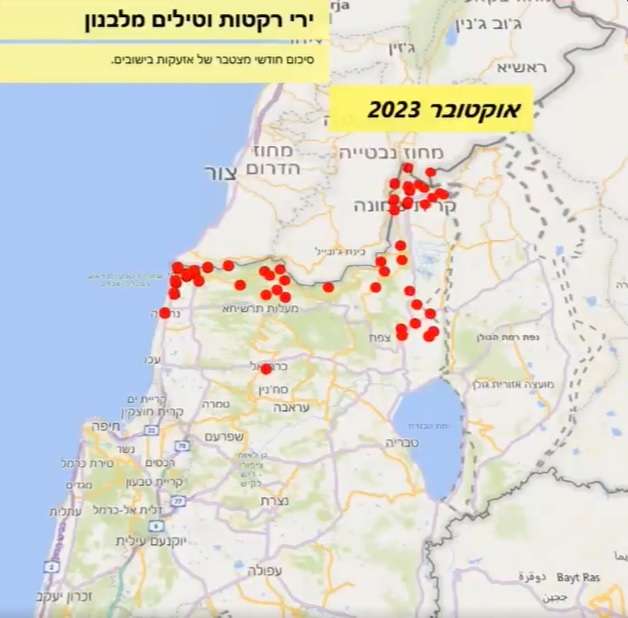
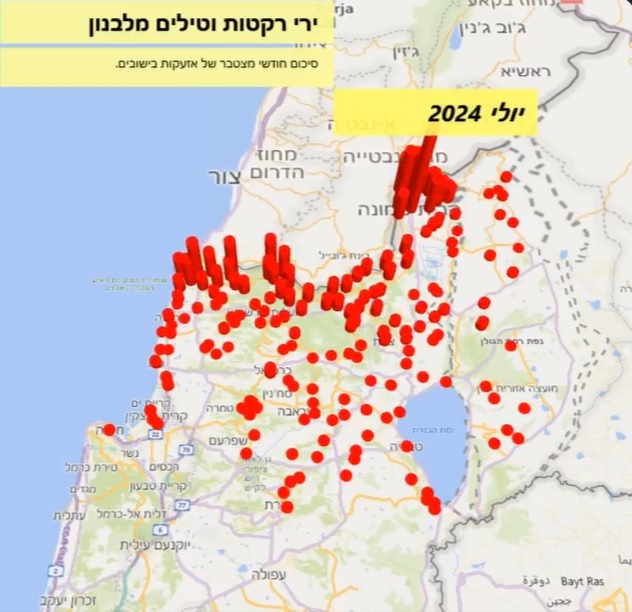
As reported recently by the Alma Center:
“From July 16 to July 22, Hezbollah launched 16 strikes to a range of more than 5 kilometers. Apart from five attacks on military targets, eleven strikes targeted civilian communities that had not been evacuated.”
So while this long BBC report leaves audiences with the impression that Hizballah is acting in a “quite calibrated” manner, the reality on the ground does not support that narrative.
As we see, the BBC has managed to produce a long and copiously illustrated report by at least six journalists on the topic of the hostilities between Hizballah and Israel which once again completely airbrushes the relevant context of UN SC resolution 1701. Despite the considerable resources obviously put in to creating this report, it does not include even one paragraph of original reporting on the highly relevant subject of the terrorist organisation’s military assets in towns and villages in southern Lebanon that are the the reason for the damage portrayed in its fancy graphics.
Related Articles:
MORE 1701 ERASURE IN BBC REPORTING FROM SOUTHERN LEBANON
BBC VERIFY TELLS A CONTEXT-FREE TALE OF DAMAGE AND DESTRUCTION
HOW THE AP (AND WAPO AND NY TIMES) LIE WITH STATISTICS (CAMERA)
BBC REPORTING ON HIZBALLAH ATTACKS AGAIN FAILS AUDIENCES
HIGH ON NARRATIVES, LOW ON FACTS: BBC’S ORLA GUERIN IN SOUTHERN LEBANON

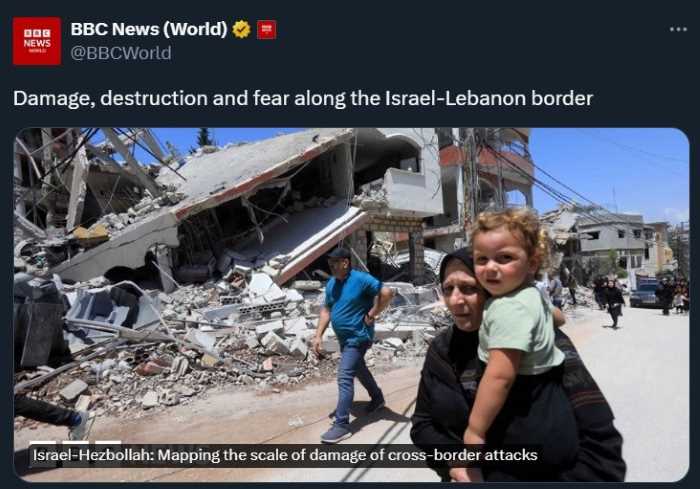

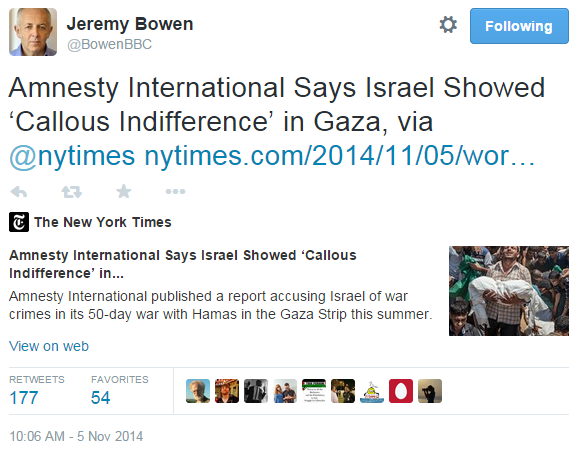
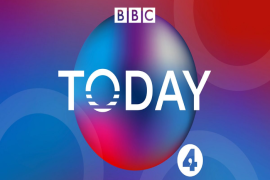

Thanks again are due to Camera for compiling this list of IPC’s (aka BBC) omissions and lies on the Hezbollah issue – but sadly its voice will not be heard above that of the IPC. Such a shame that Camera has not yet devised a way for its reports to be broadcast to the UK public at large.